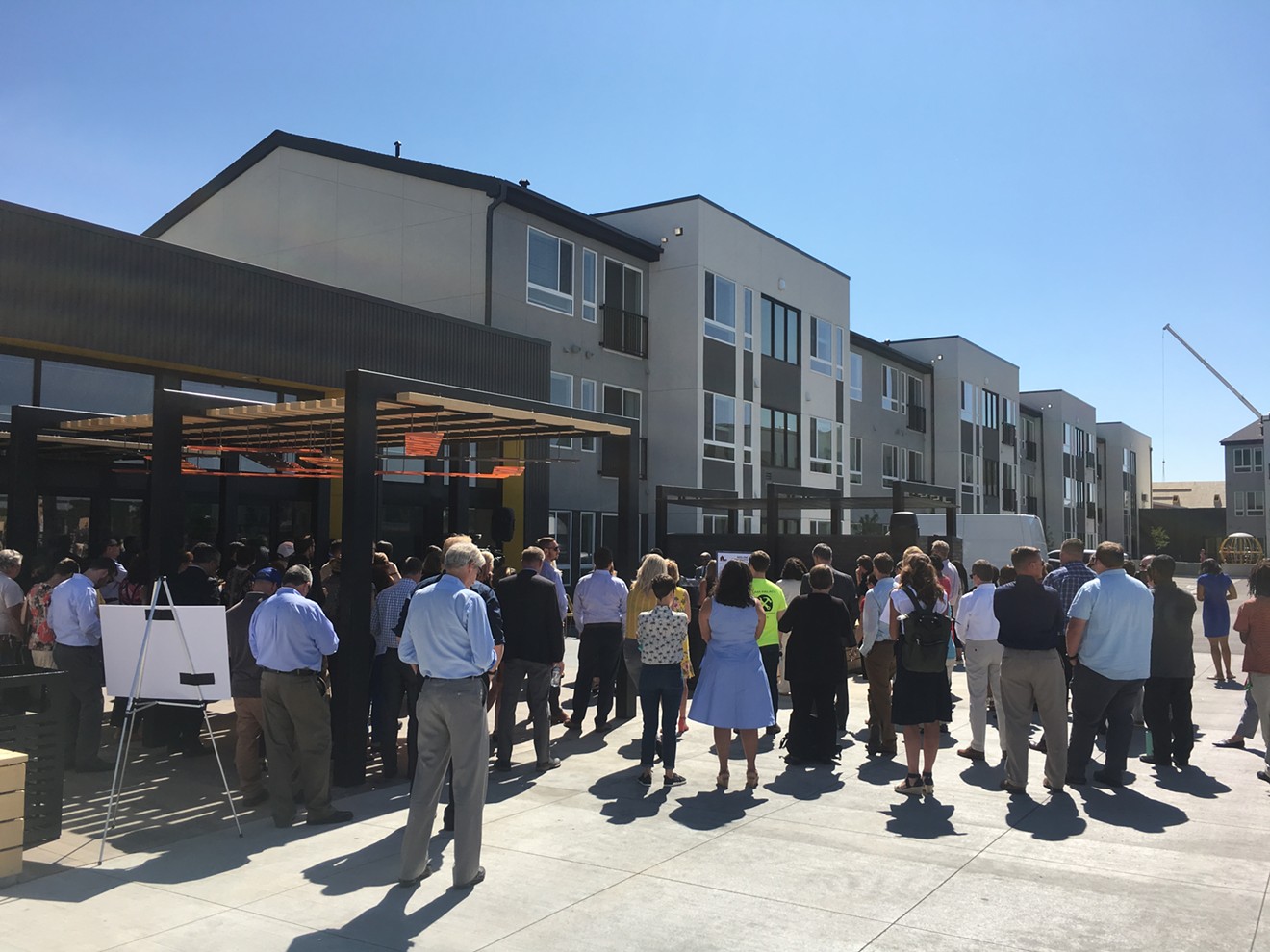Denver city officials and private partners unveiled the Moline Apartments in Stapleton on July 10, a new affordable-housing complex at the corner of Moline Street and Martin Luther King Jr. Boulevard. At the unveiling, Mayor Michael Hancock and Councilman Christopher Herndon flashed the complex’s many selling points: 180 bright, modern, energy-efficient units that are within walking distance of a light-rail station, schools, a grocery store and a large park.
The Moline Apartments are reserved for renters who earn below 60 percent of Denver's area median income, or AMI, which is $65,000 for a single-person household. Thanks to federal low-income housing tax credits, city assistance and private equity funding, those who qualify will pay no more than 30 percent of their income in rent. According to Getabecha “Gete” Mekonnen, executive director of Moline's nonprofit developer, Northeast Denver Housing Center, it has already received 150 applications, and a few families are starting to move in.
In a long-winded analogy, Hancock framed the finished complex as an accomplishment resulting from the aggressive approach he took near the end of his re-election campaign; the project is one of the first to be completed as a result of the city’s expanded Affordable Housing Fund. He compared himself to a military leader who, facing seemingly insurmountable challenges, decided that the stakes were high enough that he had to “burn the ship” to win the battle, risking death for victory. Hancock says that the Moline Apartments are one example of that bold approach: “We have created an opportunity for the residents that will live here to have great access to schools, health care and transit. For the 180 families that will be here, we have burned the ship and we have realized our destination. We didn't die; we actually won.”
But for all the apparently drastic efforts the city went through to contribute to the development, does the complex really qualify as low-income housing?
The majority of the Moline Apartments, 140 units, are reserved for those at the top income tier that qualifies — people who earn 50 to 60 percent of AMI. That’s $32,500 to $39,000 for a single-person household, and $46,400 to $55,680 for a household of four. In other words, someone who makes $39,000 should only be paying $11,700 in rent each year to meet the 30 percent threshold of affordability, which amounts to $975 per month. Still not cheap, but it's better than the citywide median one-bedroom rent of $1,530 per month, per the most recent statistics by Zumper.
Families and single people who make a moderate income and get the chance to live at Moline are certainly getting a deal that they would be hard-pressed to find in the private market, especially for such nice homes with accessible amenities. According to RentCafe, only 7 percent of apartments in the private market fall below the price this moderate income level would be paying.
Twelve of Moline's units are reserved for households earning less than 30 percent of area median income, ten are reserved for those earning between 30 and 40 percent, and eighteen are for those earning between 40 and 50 percent. Eleven of the lowest-income units are reserved for veterans and formerly homeless people who qualify for state voucher programs. The mixed-income setup can be found at five other affordable-housing complexes in Stapleton, most of which cater to the 40 to 60 percent of area median income range.
“The need for affordable housing is really broad, so we try to work with the spectrum. Yes, there is a critical need for vets and disabled, but there are families that are working hard and need affordable housing at many income levels,” Mekonnen says. “This development, from our perspective, will serve a diverse group of income range that there’s a critical need for.”
The Moline Apartments got a $2.6 million boost in funding from the city’s Affordable Housing Fund, which was doubled to $30 million annually last year as part of the city’s five-year “Housing an Inclusive Denver” plan. According to the Denver Office of Economic Development’s 2018 report, last year the majority of the fund, over $20 million, went toward subsidizing the construction and preservation of affordable-housing units like the Moline Apartments. About $6 million went toward programs that provide direct rental or home ownership payment assistance, and the remainder went to administration costs.
But administrative snafus have prevented those funds from being used effectively. A December 2018 audit knocked the city's affordable-housing program for failing to properly determine income eligibility for mortgages on its home ownership program, giving excess fees to incentivize developers and not meeting time limits on federally funded rental projects, among other flaws. And, as of April, one of its most nationally lauded programs for assisting moderate-income earners by connecting them with vacant market units, LIVE Denver, was reported to only have three beneficiaries.
The Housing an Inclusive Denver plan has yet to live up to even its own expectations for providing for those most in need; 40 to 50 percent of the funds are supposed to serve those most at risk, residents who earn under 30 percent of AMI and those experiencing homelessness. But as of the end of 2018, the city was still allocating more money to families with moderate incomes and less to efforts aiding home ownership and those experiencing homelessness. Even within the moderate-income category, the majority of funding went to families in the upper tier — that 50 to 60 percent of AMI that the Moline Apartments mainly serve.
According to Laura Brudzynski, the city's director of housing policy and programs, that's because the five-year plan is a major shift toward the lowest income levels compared to what the city has done in the past. "We have historically really seen the largest majority of our resources going toward the 31 to 80 of area median income level of affordability," she says.
According to the Office of Economic Development, the city is funding a total of 1,423 affordable-housing units that are currently under construction at eighteen sites throughout Denver. "We anticipate that we will be closer to the allocation [outlined in the Housing an Inclusive Denver plan] as we move forward in the next couple of years," Brudzynski says.
[
{
"name": "Air - MediumRectangle - Inline Content - Mobile Display Size",
"component": "12017618",
"insertPoint": "2",
"requiredCountToDisplay": "2"
},{
"name": "Editor Picks",
"component": "17242653",
"insertPoint": "4",
"requiredCountToDisplay": "1"
},{
"name": "Inline Links",
"component": "18838239",
"insertPoint": "8th",
"startingPoint": 8,
"requiredCountToDisplay": "7",
"maxInsertions": 25
},{
"name": "Air - MediumRectangle - Combo - Inline Content",
"component": "17261320",
"insertPoint": "8th",
"startingPoint": 8,
"requiredCountToDisplay": "7",
"maxInsertions": 25
},{
"name": "Inline Links",
"component": "18838239",
"insertPoint": "8th",
"startingPoint": 12,
"requiredCountToDisplay": "11",
"maxInsertions": 25
},{
"name": "Air - Leaderboard Tower - Combo - Inline Content",
"component": "17261321",
"insertPoint": "8th",
"startingPoint": 12,
"requiredCountToDisplay": "11",
"maxInsertions": 25
}
]












